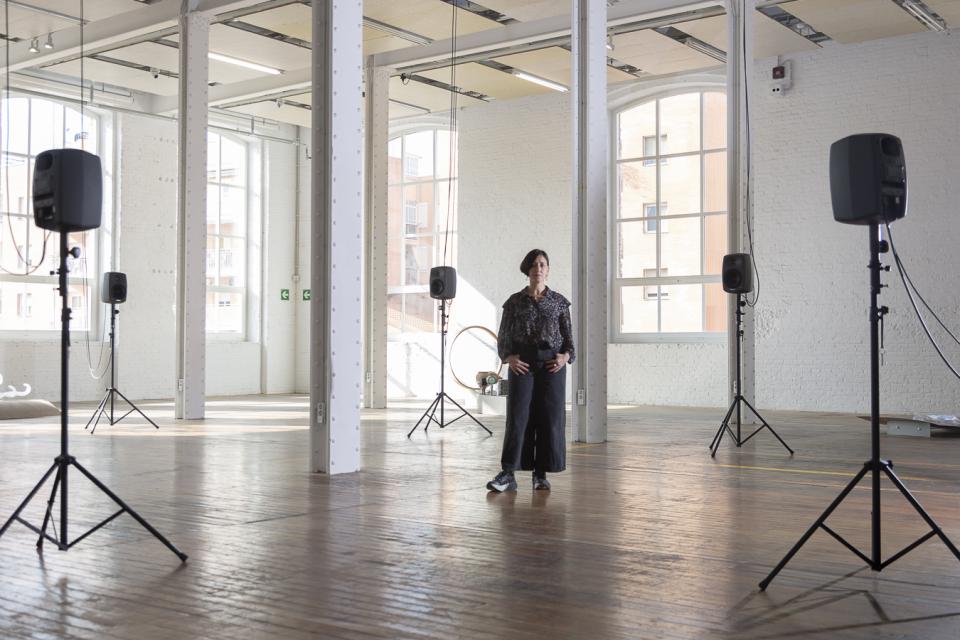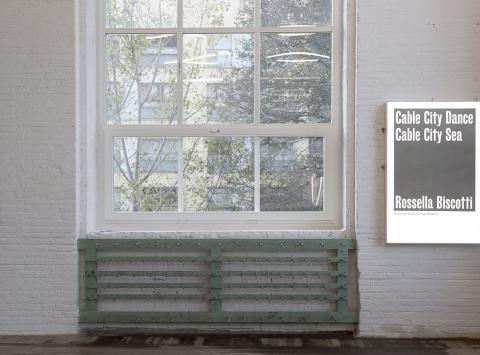Cable City Dance Cable City Sea
Rossella Biscotti’s work delves into the material and affective histories of the spaces we inhabit, unravelling systems of meaning and relational networks between the human and the non-human. Her practice, which interweaves film, sound, sculpture and performance, explores the functioning of ecosystems as open, shifting and polyphonic, as are collective imaginaries and the media by which they are conditioned, be they narrative or material. By bringing together art, archaeology, anthropology, environmental sciences, geopolitics and activism, she questions the uses and abuses of global power by revealing all that lives on the margins of official discourse.
For the exhibition at Fabra i Coats, Biscotti presents two large installations occupying two floors of the Art Centre: The City, a multi-screen projection of a Neolithic city, and The Journey, a sound piece set around the Mediterranean, accompanied by two respective sculptural works, Trees on Land and Drifting, which take us to an olive tree cemetery and to the currents of the sea. Between the two floors, another work connects them physically and conceptually from within the building's infrastructure: A Conductor, a recycled cable from a decommissioned nuclear power station, is connected to the Art Centre's electrical supply and provides power for the entire exhibition.
On the ground floor, the site of The City takes us underground to interpret, preserve, and archive the remains of a prehistoric city. However, this creates a void where there was none, while generating new layers of decontextualised meaning (diaries, boxes, digital databases…). Similarly, the ceramics in Trees on Land, made from olive ash and clay, speak of the void left by the incinerated trees and the bare land that remains after the fires which were started to contain the spread of one of the world's most devastating plant bacteria. Excavation as an interpretative opening meets extraction as a hole, a dislocation that we actively manipulate from the present. A Conductor is an example of the interests hidden in a material that the artist reuses to reconnect with society. By pointing out burning issues such as energy wars, nuclear power, environmental regulation and recycling, Biscotti creates a small short-circuit within the art institution: she appropriates the Art Centre's energy, illuminating and connecting all the works - here invisibly, whereas above appears as a labyrinth of tentacles. Against the weight and opacity of the underground, ancestors, roots, and cables are uprooted, relocated, and buried again in an archive or burned and transformed into new cultural, and thus political, signals.
On the upper floor, the imageless narrative of The Journey immerses us in the sea, expanding the acoustic and metaphorical range of the twenty-ton block of Carrara marble that is the origin of the work. The artist loaded this stone onto a merchant ship and, after three days sailing between Italy, Malta, Tunisia, and Libya, threw it into the sea. This parable connects the exploitation of the Carrara quarries with one of the crucial points between Africa and Europe, through which thousands of migrants pass and die today, and through which fishermen and naval fleets have passed and perished in so many battles, from the Punic Wars to World War II. Two natural enclaves, the mountain and the sea, that live off destruction due to human action or inaction. The “journey” is therefore not only that of the stone, but of all of us following its path and the implications it points to beyond itself. Thus, here, the waves of the sea become sound and electromagnetic waves, revealing all the textures of marble extraction or a high-sea voyage (among them radio signals, birds, storms, engine vibrations, or the words of sailors and activists) to tell us that there is no silent matter or landscape. In the same room, immersed in the swing and flow of the sea, we find Drifting, a sculptural series that resembles plankton, an erratic body of microscopic organisms that float on the seabed and one of the planet's main oxygen producers. These invertebrates made of blown air and Murano glass intertwine with the electric arms of A Conductor in a physical and ethereal dance.
Below, darkness and emptiness force us to sharpen our vision to search for traces of the hands of humanity and see to what extent we manipulate and transform our environment, whereas above, light and amplification of the most indiscernible kind invite us to sharpen our hearing, to make evident the myriad interests surrounding us, and at the same time, to devote time and attention to what has been forgotten or relegated to the margins. With this double critical exercise that takes us from the micro (archaeological remains, microorganisms, micro-histories) to the macro (scientific discourses, power structures, material constraints), and vice versa, Biscotti reveals what is usually unseen or deliberately overlooked, either because it is not perceptible, is deliberately hidden, or is minimised by the indifference of a broad majority.
Revealing the politics of visibility to point out the infrastructures and their invisible channels of information makes us aware of two things: on the one hand, the control strategies and the impact we have on our environment, that is, everything hidden beneath the apparent superficiality of these vast masses of land and water (or ash, marble, glass, air...); and on the other hand, how we make sense of our surroundings while ignoring the active role of material culture. Understanding the parallels between the community being unearthed and the one doing the unearthing, between the destructive action of bacteria and the fire used to combat it, between the waves of the sea and those of sound, between the energy of plankton and that of a recycled cable, leads us to question our ethnocentric conception of the world in terms of heritage, energy or landscape, but also in terms of life and death.
Living in the world implies making it, creating it. What seems to us like an excavated desert and the vastness of the sea, Rossella Biscotti tells us, is also a constructed landscape that structures our experience and vision of the world. The lack of an absolute image or perspective that can unify the multiplicity of views and voices of these two spaces not only serves to reflect on the articulation of societies, present or past, but also allows for new perceptions of our relationship with the environment. And if our interaction creates our conception of the world, it can also change it.
18/11, at 12.00 pm - Opening with free babysitting service for children aged 4 to 12 from 11.30 to 14.00 h. For more information about the service, visit the link.
Advance reservation is required: activitatios-centredart@bcn.cat.
With the support of:
![]()






